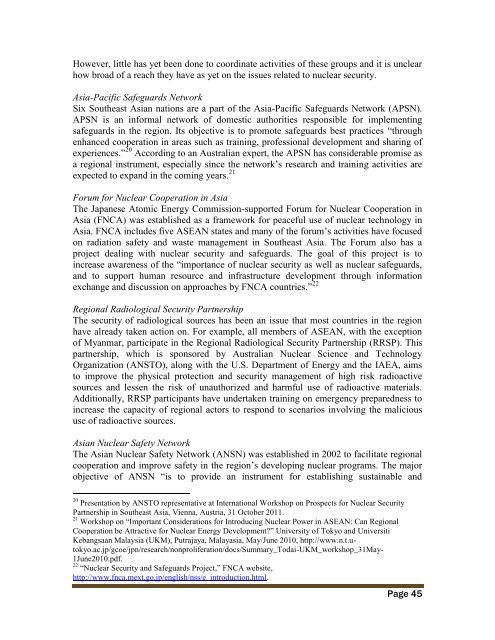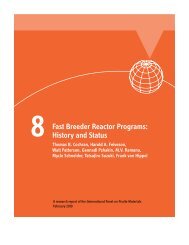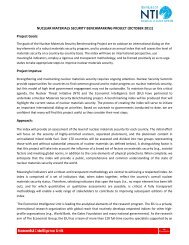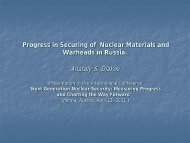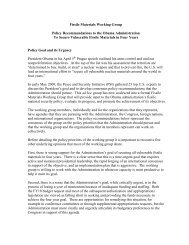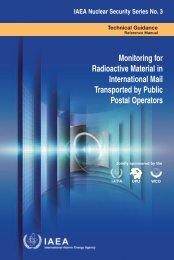Prospects for Nuclear Security Partnership in Southeast Asia - CNS
Prospects for Nuclear Security Partnership in Southeast Asia - CNS
Prospects for Nuclear Security Partnership in Southeast Asia - CNS
You also want an ePaper? Increase the reach of your titles
YUMPU automatically turns print PDFs into web optimized ePapers that Google loves.
However, little has yet been done to coord<strong>in</strong>ate activities of these groups and it is unclearhow broad of a reach they have as yet on the issues related to nuclear security.<strong>Asia</strong>-Pacific Safeguards NetworkSix <strong>Southeast</strong> <strong>Asia</strong>n nations are a part of the <strong>Asia</strong>-Pacific Safeguards Network (APSN).APSN is an <strong>in</strong><strong>for</strong>mal network of domestic authorities responsible <strong>for</strong> implement<strong>in</strong>gsafeguards <strong>in</strong> the region. Its objective is to promote safeguards best practices “throughenhanced cooperation <strong>in</strong> areas such as tra<strong>in</strong><strong>in</strong>g, professional development and shar<strong>in</strong>g ofexperiences.” 20 Accord<strong>in</strong>g to an Australian expert, the APSN has considerable promise asa regional <strong>in</strong>strument, especially s<strong>in</strong>ce the network’s research and tra<strong>in</strong><strong>in</strong>g activities areexpected to expand <strong>in</strong> the com<strong>in</strong>g years. 21Forum <strong>for</strong> <strong>Nuclear</strong> Cooperation <strong>in</strong> <strong>Asia</strong>The Japanese Atomic Energy Commission-supported Forum <strong>for</strong> <strong>Nuclear</strong> Cooperation <strong>in</strong><strong>Asia</strong> (FNCA) was established as a framework <strong>for</strong> peaceful use of nuclear technology <strong>in</strong><strong>Asia</strong>. FNCA <strong>in</strong>cludes five ASEAN states and many of the <strong>for</strong>um’s activities have focusedon radiation safety and waste management <strong>in</strong> <strong>Southeast</strong> <strong>Asia</strong>. The Forum also has aproject deal<strong>in</strong>g with nuclear security and safeguards. The goal of this project is to<strong>in</strong>crease awareness of the “importance of nuclear security as well as nuclear safeguards,and to support human resource and <strong>in</strong>frastructure development through <strong>in</strong><strong>for</strong>mationexchange and discussion on approaches by FNCA countries.” 22Regional Radiological <strong>Security</strong> <strong>Partnership</strong>The security of radiological sources has been an issue that most countries <strong>in</strong> the regionhave already taken action on. For example, all members of ASEAN, with the exceptionof Myanmar, participate <strong>in</strong> the Regional Radiological <strong>Security</strong> <strong>Partnership</strong> (RRSP). Thispartnership, which is sponsored by Australian <strong>Nuclear</strong> Science and TechnologyOrganization (ANSTO), along with the U.S. Department of Energy and the IAEA, aimsto improve the physical protection and security management of high risk radioactivesources and lessen the risk of unauthorized and harmful use of radioactive materials.Additionally, RRSP participants have undertaken tra<strong>in</strong><strong>in</strong>g on emergency preparedness to<strong>in</strong>crease the capacity of regional actors to respond to scenarios <strong>in</strong>volv<strong>in</strong>g the malicioususe of radioactive sources.<strong>Asia</strong>n <strong>Nuclear</strong> Safety NetworkThe <strong>Asia</strong>n <strong>Nuclear</strong> Safety Network (ANSN) was established <strong>in</strong> 2002 to facilitate regionalcooperation and improve safety <strong>in</strong> the region’s develop<strong>in</strong>g nuclear programs. The majorobjective of ANSN “is to provide an <strong>in</strong>strument <strong>for</strong> establish<strong>in</strong>g susta<strong>in</strong>able and20 Presentation by ANSTO representative at International Workshop on <strong>Prospects</strong> <strong>for</strong> <strong>Nuclear</strong> <strong>Security</strong><strong>Partnership</strong> <strong>in</strong> <strong>Southeast</strong> <strong>Asia</strong>, Vienna, Austria, 31 October 2011.21 Workshop on “Important Considerations <strong>for</strong> Introduc<strong>in</strong>g <strong>Nuclear</strong> Power <strong>in</strong> ASEAN: Can RegionalCooperation be Attractive <strong>for</strong> <strong>Nuclear</strong> Energy Development?” University of Tokyo and UniversitiKebangsaan Malaysia (UKM), Putrajaya, Malayasia, May/June 2010, http://www.n.t.u-tokyo.ac.jp/gcoe/jpn/research/nonproliferation/docs/Summary_Todai-UKM_workshop_31May-1June2010.pdf.22 “<strong>Nuclear</strong> <strong>Security</strong> and Safeguards Project,” FNCA website,http://www.fnca.mext.go.jp/english/nss/e_<strong>in</strong>troduction.html.Page 45


